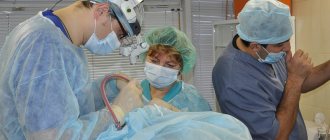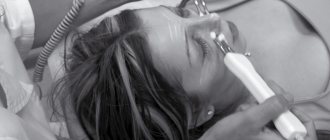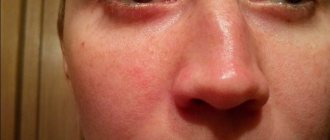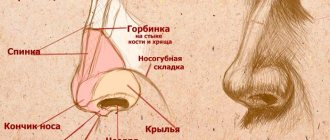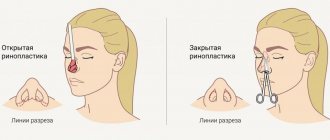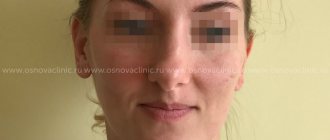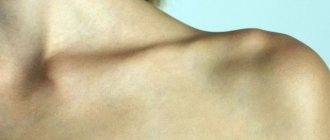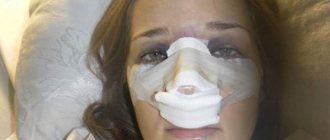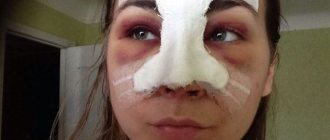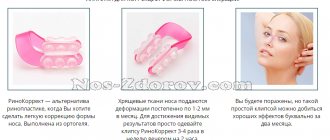Nose correction is considered a very popular operation. Many women, and men too, want to change the small imperfections of their nose, making it aesthetically perfect. Like any other surgical procedure, rhinoplasty is also accompanied by swelling in the working area. This phenomenon is absolutely normal. There is no need to be afraid of him.
It is impossible to avoid swelling after rhinoplasty, but you can help it go down as quickly as possible. To do this, you need to listen carefully to your surgeon and carefully follow all recommendations, prescriptions and prohibitions. Only this approach will speed up the tissue healing process and stimulate the rapid resorption of swelling and bruises, and therefore the restoration of normal facial aesthetics.
Causes of edema
During surgery, the doctor makes incisions in the operating area. During the incisions, the tissues and vessels of the nose are in any case injured. To give the tip a new shape, the surgeon also removes tissue. During surgery, special medications stop the development of bruises and swelling, but after the intervention, the injured area is filled with fluid, which promotes tissue healing.
Thus, swelling is nothing more than the result of the body’s activity to regenerate damaged areas of the nose. Swelling can be located not only in the nose area, but also on the chin or cheeks. When the damaged tissues and blood vessels are restored, and blood supply is established in the operated area, the swelling will subside on its own.
Swelling of the tip of the nose lasts for several months.
When are turundas removed from the nose after rhinoplasty?
Turundas are installed in the nose after rhinoplasty to prevent bleeding and to support the nasal septum in the desired position. This makes it difficult to breathe through your nose.
Turundas are removed one or two days after surgery. This is done carefully and quickly, so the patient does not have time to feel pain.
After removing the cotton swabs, internal swelling appears, which also makes breathing difficult. Over time it goes away. If you are interested in information about edema, check out the article on primary and secondary edema.
What affects swelling?
Firstly, this is the volume and complexity of the operation. The greater the number of tissues that undergo changes, the longer the regeneration period will be in the future. At the tip of the nose, as a rule, the swelling is quite strong, since in this area the nose has a complex structure. After correction of the back or wings, rehabilitation takes less time. But after septoplasty, swelling can linger for up to several months.
The age of the patient is also important. The older the patient, the less regenerative abilities of the body, so swelling will last a little longer than in younger people. If this is not the first operation on the nose in the patient’s life, the swelling will also linger for an extended period. Finally, compliance with recommendations in the postoperative period is also important.
What determines the size of nasal swelling after rhinoplasty?
If you have ever had a nose injury, you may have noticed that in the event of mechanical damage to the tissue, the septum swells more. This is due to the fact that the skin on the nasal septum is thinner than at the tip. Visual swelling strongly depends on the thickness of the skin. And if the skin on the tip of your nose is tender and thin, you need to prepare for swelling.
In addition to the thickness of the skin, edema depends on several other factors: the age of the patient, the skill of the surgeon, the type of anesthesia, and compliance with the doctor’s recommendations. By the way, the doctor’s recommendation not to smoke before and after surgery is very important. The fact is that smokers have weak capillaries and, due to their addiction, the recovery process can be delayed until tissue necrosis occurs. If you want to smoke like crazy, stop at 3-5 cigarettes a day. But this is also a compromise and undesirable option.
How long does swelling last after tip rhinoplasty?
To begin with, it should be noted that swelling appears some time after the operation and only grows over the course of several days. This is natural, no need to worry. The maximum peak of development occurs approximately on the third day after surgery, then the swelling begins to subside.
Swelling of the tip after rhinoplasty lasts the longest, compared with the results of correction of the back or wings - about a year and a half. But this absolutely does not mean that during this period there will be pronounced swelling, causing physical and psychological discomfort! Visual swelling, noticeable to the naked eye, lasts about three weeks. After this, only the professional eye of a surgeon can notice the presence of swelling. Secondary swelling persists for several months after surgery. Over the course of a year, there is a gradual decrease in the size of the nose. After this period, you can sum up the final results of the correction and talk about the final result.
Nasal tip surgery allows you to achieve impressive aesthetics.
Reviews
Irina : “5 years have passed since the operation, at first the swelling was terrible, in general the swelling of the tip went away within a year. To help the tissue recover faster, I was injected with Diprospan.”
Svetlana : “My new nose is nine months old. They straightened my septum and made the tip. The bruises went away quickly, there was uneven swelling and it lasted for 2 weeks. One side did not breathe, and the tip moved to the side for the first 3 months. Now it's normal".
Valeria : “5 months have passed since the operation, I’m happy that I made the decision. At first there was swelling of the eyes and nasal tissues, but now there is nothing. There were no bruises after the operation, the doctor was apparently excellent.”
Julia : “I waited a long time for the swelling to go down, I was upset for a year, I even wrote a negative review of the surgeon. I had to have a repeat rhinoplasty in another clinic. After it, I recovered in just 2 months.”
How to relieve swelling
To help the patient cope with swelling, plastic surgeons recommend following a number of instructions:
- review your diet - give up salty and spicy foods,
- do not visit the bathhouse or sauna,
- do not take hot baths,
- limit physical activity,
- apply cold compresses,
- sleep half-sitting
- give up alcohol and cigarettes.
Salt and hot seasonings contribute to water retention in the body, and this, in turn, adversely affects the rate of resorption of edema. Hot baths and other thermal treatments stimulate blood flow to the injured area, which negatively affects the rate of healing. On the contrary, a cold compress has a beneficial effect on swelling, helping to accelerate its decline, and stimulates tissue regeneration.
It is important to understand that all these measures are not lifelong, but only for the period of recovery. It is in the patient’s interests to follow these rules to help his body recover as quickly as possible.
How to treat bruises after rhinoplasty?
After rhinoplasty, bruising can be considered a natural, expected complication. They arise due to the fact that blood vessels are inevitably injured during surgery.
To reduce bruising immediately after surgery, your doctor may apply ice, if appropriate.
Then the patient can use ointments, special lotions, do a light facial massage, do prescribed physical procedures and follow all the surgeon’s recommendations.
It is best to consult with your plastic surgeon before deciding which ointment to use. Maybe it will be Badyaga, maybe Traumeel-S gel and so on.
Bruises should disappear completely within two weeks after surgery.
Medications
Depending on the patient’s condition, the doctor may prescribe certain medications. If there is a slight increase in temperature, antibacterial drugs may be prescribed, and analgesics may be prescribed to relieve pain.
Special gels and ointments with absorbable and healing effects will help relieve swelling of the tip after rhinoplasty as soon as possible. For example, it could be “Traumel” or “Badyaga” ointment. These types of drugs are prescribed only after bleeding in the correction area has gone away.
Residual effects of edema are removed with injections with Diprospan or compresses with Dimexide. But these drugs are quite dangerous when used without a doctor’s prescription - it’s easy to make a mistake with the dosage and harm yourself even more. Therefore, only the surgeon who performed rhinoplasty can prescribe certain medications. It is strictly not recommended to prescribe medications on your own! The consequences can be unpredictable.
Reviews of Diprospan injections against swelling after rhinoplasty.
Some patients praise the drug for its ability to quickly relieve swelling, while others criticize it for its terrible side effects. What is Diprospan? This is a steroid hormone with a pronounced anti-edematous and anti-inflammatory effect. After rhinoplasty, it is used to reduce the formation of granulation tissues and relieve persistent swelling in the area of the tip of the nose. Its properties are generally useful, but are applicable only to specific cases if indicated. There are also a number of negative reviews about Diprospan from patients online.
Plastic surgeons rarely prescribe the drug, mainly for real problems with long-term swelling and slow tissue regeneration. For people who simply want to reduce the severity of edema, easier options for rehabilitation therapy are recommended - hardware and injection cosmetic procedures that stimulate the body's own resources.
Complications after rhinoplasty
The operation is quite complicated, but a qualified surgeon and a good clinic reduce the risks to a minimum. However, sometimes unintended consequences may arise. If a patient experiences a very high body temperature for several days, or the nose does not stop bleeding, or purulent discharge appears, this is a sufficient reason to contact your specialist as soon as possible.
It is also worth consulting with a surgeon if the operated area is painful or the swelling of the tip of the nose lasts too long. But don’t panic if the period for the swelling to subside slightly differs from the one announced by the surgeon: the recovery period for each patient is individual, determined by physiological parameters. Therefore, a slight deviation is acceptable.
Swelling from the third to the ninth month after rhinoplasty: how to reduce it?
From the third month, the swelling becomes completely invisible to others. The nose begins to acquire clear outlines and elegance. At this point, you can notice a softening of the tip and a reduction in the seals on the sides of the nose. Aesthetic restoration occurs gradually, but the patient himself notices positive “transformations” of the nose every day.
At the last stage of rehabilitation, the number of prohibitions decreases, but it is optimal for you to continue to adhere to a healthy lifestyle. By the end of the 6th month, you can approximately see the final result of rhinoplasty, especially if the skin on the nose is normal.
With thick, oily and porous skin, swelling takes longer to resolve, and the final effect of tip rhinoplasty becomes noticeable after 8-9 months.
How to deal with nasal swelling after rhinoplasty?
The fight against edema begins even before surgery. In what sense? A few days before surgery, the patient needs to completely stop smoking, drink alcohol and limit the intake of certain medications.
Then the plastic surgeon plays his role. Even during the operation, he uses special drugs that reduce tissue swelling. About how Grigoryants V.S. does it. We invite you to find out from the following video.
After surgery, swelling will certainly occur. However, the patient can either enhance its formation or help restrain it.
This will depend on:
- how a person sleeps (you only need to sleep on your back with your head elevated)
- what the patient eats (it is not recommended to eat a lot of salt, which retains fluid)
- whether the person is exposed to physical activity (for the first 10 days, you should avoid exertion, especially if you can’t tilt your head down), etc.
- does the person avoid smoking and alcohol?
To reduce swelling, the doctor prescribes physiotherapeutic procedures (microcurrent therapy, massage, electropheresis, etc.) and appropriate treatment.
